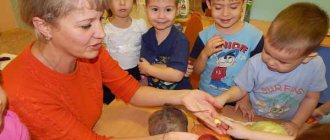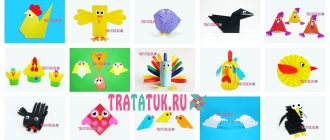Methods and techniques
In the course of his work, the teacher uses different teaching technologies. Some people turn their classes into theater and an interesting production, while others use modern technologies. All this makes the process fun and colorful.
Projectors and presentations make class preparation easier
For each lesson, the teacher writes a summary that contains all the goals and stages of the work.
Verbal methods
In preschool age, only story, explanation and conversation are used. The teacher should write a short text on the topic and provide interesting facts. For example, if the topic is “Wild Animals,” then you can select visual pictures and tell the features of the habitat of different species.
How to teach a child to count - effective and proven methods
Important! Do not overload the text with scientific terms.
Conversation is more difficult to use, since the teacher needs to come up with a series of leading questions that will help arrive at new material. In the case of the Space theme, this is everything related to the sky, stars, etc.
Gaming technologies
Games can have different purposes - educational, social or cognitive. In elementary school, these types of teaching can also be used in lessons, as they make the process more effective.
For classes, you can use a fairy-tale character or another hero. It will attract children's attention and make learning interesting.
Didactic games
Presented in different versions - “Find the odd one out”, “Guess the riddle”, “Divide into groups” and others. It all depends on what the teacher’s goal is.
For example, for the topic “Transport” you can select pictures of air, land and water transport. Children need to divide them into three groups or exclude unnecessary ones.
Outdoor games
Physical education sessions are aimed at switching children’s activities. They allow them to take a break from study time, release energy and unwind.
Important! They are held in the middle of the lesson.
For outdoor games you will need a ball. You can do a simple option: each child must throw the ball and name the vegetable. Small warm-ups can be done at the beginning of the lesson. In this case, they offer the following task: only the one who names the profession of his parents will sit.
Case studies
A simple option is observation. The teacher and the children keep a diary of records about the weather or changes in the outdoor area. In a preschool institution, simple experiments are carried out - growing seeds, studying ice, etc.
All tasks should be selected taking into account the age of the children
In the preparatory group, observation can be expanded. For example, asking children to measure the length of an object and describe its important features - color, appearance, etc.
Preparing for an open lesson
The work of the teacher is checked by specialists from the district education department. Special demonstrations of classes are held for them, which give them the opportunity to see the teacher’s activities live.
Activities like these prepare children for school
Standards of Federal State Educational Standards
A lesson on familiarization with the outside world in the preparatory group must meet modern requirements. In the introductory part, motivation for children and a problematic situation are created; in the main part, various leadership techniques can be used.
Important! The teacher’s task during the lesson is to encourage children’s speech activity. To do this, the teacher asks leading questions.
According to federal state standards, the teacher must organize the activities of preschoolers and alternate types of activities. At first they can sit at tables, then on the floor and walk around the room.
According to the requirements of the Federal State Educational Standard, the teacher must pay special attention to visual materials. They must be of high quality, colorful, colorful.
Methodological literature
In his work, the teacher must rely on different sources. The book “Introducing children 3-5 years old to the world around them”, edited by T. Vostrukhina, has proven itself well. The manual meets educational standards and work can be built on its basis.
For the preparatory group, you can use Chistyakova’s book “Getting to Know the World Around You.” It is suitable not only for teachers, but also for parents.
There are different workbooks. For example, it is popular under the authorship of T. Kolpakova or E. Bortnikova. They contain simple tasks to complete.
Recommended lesson topics
According to federal state standards, a teacher must demonstrate something new in an open lesson. When choosing a topic, you should focus on calendar planning.
In classes on the surrounding world, they study natural phenomena, animal species and much more.
In September, children go through topics such as the time of year, introduction to kindergarten, and others. At this time, you can study the types of mushrooms, identifying edible and poisonous species.
In the fall, preschoolers study topics related to migratory and wintering birds and forest trees. Children conduct various experiments, play and explore the world.
GCD for familiarization with the outside world in the preparatory group
In winter, they take on themes that are associated with the New Year and seasonal types of entertainment. Parents must be included in the work and do homework.
In the spring there are themed parties, quizzes and weeks of open classes.
Goals and objectives of the open lesson
In the first junior group, teachers develop an interest in learning and introduce children to representatives of flora and fauna. Teachers help improve the functioning of auditory and visual analyzers. The main task is to isolate and highlight the characteristics of objects.
Important! When setting a lesson goal, you should always take into account the age of the children.
In the second junior group, children learn to conduct experiments and form primary ideas about the world around them. During this period, the ability to create cause-and-effect relationships is developed.
In the middle group, the skill of independent work is developed. It is not enough to surround the child with different colorful materials, it is important to teach how to work with them.
Children learn to build simple patterns and make monologues. During this period, preschoolers must identify characteristic features. For example, wild animals in the north have thick and long fur, which keeps them warm.
In the older group, children can analyze their activities and build coherent stories. The number of ways to record information is increasing - verbally describing the weather, drawing the stages of germination of a bulb, etc.
In the preparatory group, preschoolers develop thinking, the ability to draw conclusions, and compare facts. They can make discoveries in everyday life. At this time, the teacher’s task is to promote the formation of the skill of putting forward hypotheses and the ability to prove them.




